
 |
| Most Recent Technical Activities | Physics Laboratory home page |
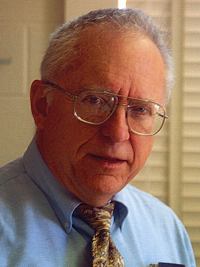 |
NobelDr. John (Jan) L. Hall, scientist emeritus in the NIST Quantum Physics Division and a fellow of JILA, a joint research institution of NIST and the University of Colorado in Boulder, CO. He shared the 2005 Nobel Prize in Physics with Theodor W. Hänsch of the Max-Planck-Institute of Quantum Optics, Garching and Ludwig-Maximilians-Universität, Munich, Germany, and Roy J. Glauber of Harvard University. Hall and Hänsch were cited, "for their contributions to the development of laser-based precision spectroscopy, including the optical frequency comb technique." |
Service to America MedalWilliam D. Phillips, Atomic Physics Division, was awarded a 2006 Service to America Medal (Career Achievement) by Government Executive Magazine and the Partnership for Public Service. He was recognized for service to America as an ambassador for science and the Federal workforce.In 1997, when he was awarded a Nobel Prize in Physics for his pioneering research on the laser cooling and trapping of atoms, he accepted new responsibilities that he believed came with this great honor. Primary among these was a commitment to share the thrill of discovery and the privilege of a career in government science. Dr. Phillips' dedication and extraordinary devotion to public speaking are legendary, as are the content of his talks. He has given numerous official talks, mostly at universities and conferences. But less common for a Nobel Laureate are the many inspiring talks he has given on his own time to churches, schools, science fairs, senior centers, minority institutions, and charitable organizations. |
 |
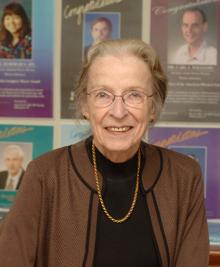 |
Accenture Government Women’s Leadership AwardKatharine B. Gebbie, Director, Physics Laboratory received the 2006 Accenture Award in the Government Visionary category. "In her 15 years of leadership at NIST's Physics Lab, Dr. Gebbie has repeatedly proven her dedication to the spirit of scientific discovery and teamwork. Under her direction, scientists from NIST have received three Nobel Prizes, and her leadership has led to improvements in the quality of clinical mammography, port entry radiographic devices, and the irradiation of potentially contaminated mail." |
2006 'Scientific American 50'David J. Wineland, Time and Frequency Division, has been named to the 2006 list of the Scientific American 50, along with Christopher Monroe of the University of Michigan at Ann Arbor, for his research on quantum computing. Dr. Wineland was recognized in particular for leading a research group that this year created a novel electromagnetic trap for ions that could be easily mass produced to potentially make quantum computers large enough for practical use. |
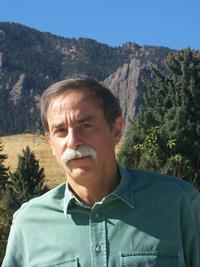 |
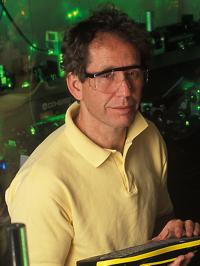 |
I. I. Rabi Prize in Atomic, Molecular, and Optical PhysicsJohn C. Bergquist, Time and Frequency Division, received the 2006 Rabi Prize “for seminal contributions to laser spectroscopy and the realization of accurate optical frequency standards. |
I. I. Rabi Prize in Atomic, Molecular, and Optical PhysicsDeborah Jin, Quantum Physics Division, received the 2005 Rabi Prize “for her pioneering work in the production of degenerate Fermi gases and exploitation of their novel physical properties. |
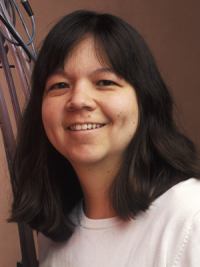 |
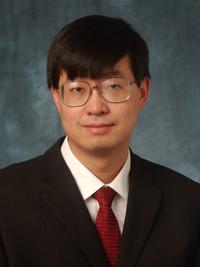 |
William F. Meggers AwardJun Ye, Quantum Physics Division, received the 2006 Meggers Award of the Optical Society of America "for development of innovative spectroscopic measurement techniques based on femtosecond optical frequency combs." |
George C. Pimentel Prize for Advances in Matrix Isolation SpectroscopyMarilyn Jacox, Scientist Emeritus, Optical Technology Division, received the 2005 Pimentel Prize for her many major contributions to matrix isolation spectroscopy, including, most recently, investigations of highly unstable negative ions and negative ion clusters. |
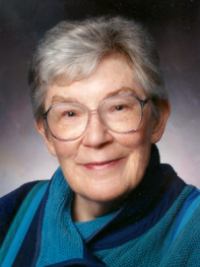 |
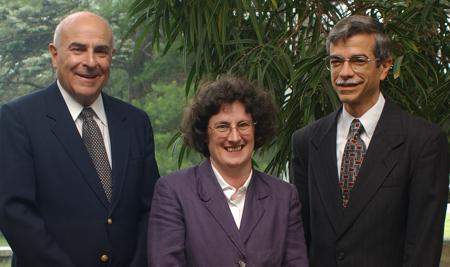 |
NASA Group Achievement Award - joint with staff of the
Joseph Reader, Craig Sansonetti, and Gillian Nave, (joint with
staff of the Space Telescope-European Coordinating Facility) received a
2006 NASA Group Achievement Award in recognition of painstaking efforts
to provide maximum scientific value to Hubble Space Telescope data using
precision laboratory spectral measurements and physical instrument modeling
techniques. |
Presidential Early Career AwardThe Presidential Early Career Awards for Scientists and Engineers, established in 1996, is the highest honor bestowed by the U.S. government on scientists and engineers beginning their independent careers. Sixty awards were given nationally and presented in a White House ceremony. |
| J. Trey Porto, Atomic Physics Division, received a 2005 Presidential Early Career Award for Scientists and Engineers for world-class research on neutral-atom quantum computing and novel quantum properties of atoms in one-dimensional systems, as well as for serving as a mentor to students, postdoctoral fellows, and other researchers. |  |
Arthur S. Flemming AwardsEstablished in 1948, the Flemming Awards honor outstanding Federal employees with no more than fifteen years of government service. Recognized by the President of the United States, agency heads, and the private sector, about ten winners are selected each year from all areas of the Federal service. |
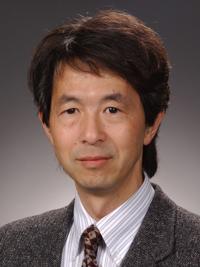 |
Yoshi Ohno, Optical Technology Division, was recognized with a 2006 Flemming Award for his innovative research and international leadership in the optical sciences of photometry and colorimetry. In support of NIST's mission to promote U.S. innovation and industrial competitiveness, he has developed photometric and colorimetric measurement technology and technical standards to advance the U.S. lighting, imaging and display industries. His research is accelerating the development of solid-state lighting and its promise of 10% reduction in electricity usage in the USA by providing the tools to assess and optimize the performance of novel light sources. |
| Carl J. Williams, Chief, of the Atomic Physics Division, was recognized with a 2006 Flemming Award for definitive theories of the physics of ultracold atoms and molecules, and their application to precision measurement, atomic clocks, and the new fields of Bose-Einstein and fermionic condensation and quantum computing. He is a world leader in applying quantum mechanics to model the collision of atoms and molecules at temperatures near absolute zero. His work has been highly influential in the burgeoning field of ultracold atomic physics, which has been recognized by two recent Nobel Prizes. The calculations done by Dr. Williams and his associates have guided critical experiments, enabling the attainment of new condensate species and pointing the way to novel quantum information processing applications. |  |
 |
Jun Ye, Quantum Physics Division, was recognized with a 2005 Flemming Award for his contributions to the fields of precision measurement, quantum optics, ultrasensitive detection, and cold molecules. He developed techniques to coherently combine the output of independent lasers and the successive pulses emitted by a single laser. He demonstrated a unified time and frequency spectroscopy of atoms using phase-stabilized femtosecond lasers. Dr. Ye's accomplishments have enabled new advances in chemically-specific microscopy and the design of precision optical instruments and help maintain NIST leadership in the international metrology community. |
| Keith R. Lykke, Optical Technology Division, was recognized with a 2005 Flemming Award for the development of novel laser technology for the accurate calibration and characterization of optical instruments used in ground and satellite-based remote sensing, missile defense and targeting, and standards research, development, and dissemination. This technology has led directly to improved values for ocean carbon levels important in climate change research, to innovative high-temperature pyrometers critical to the development of a new International Temperature Scale, and to approaches to reliably correct for stray light affecting the accuracy of multimillion dollar satellite environmental optical sensors. | 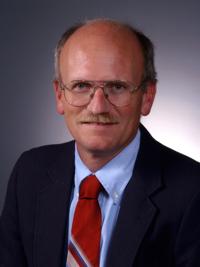 |
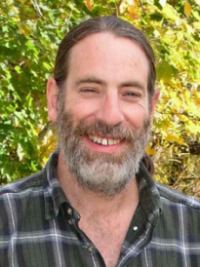 |
Steven Jefferts, Time and Frequency Division, was recognized with a 2005 Flemming Award for outstanding technical and managerial leadership of NIST-F1, the world’s most accurate atomic clock. Dr. Jefferts has led the design, construction, operation, and continual improvement of NIST-F1, the first U.S. laser-cooled frequency standard, from its earliest conception in 1996. NIST-F1, the U.S. national standard for the second, is one of the most visible and widely-used assets of NIST. NIST time, calibrated by the NIST-F1 atomic clock, is used literally billions of times each day for everything from setting consumer timepieces, to ensuring the accurate time-stamping of hundreds of billions of dollars of electronic financial transactions, to coordinating the most precise international time. |
Sigma Xi Young Scientist Award for Excellence in Scientific ResearchJason Crain, Electron and Optical Physics Division, was the recipient of the 2006 NIST Chapter of Sigma Xi Young Scientist Award for work leading to the discovery of "end states" in one dimensional atom chains and elucidating electronic effects in the length distributions of one dimensional chains of atoms. |
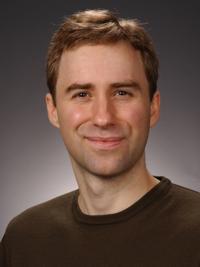 |
Fellowship of the National Academy of SciencesThe National Academy of Sciences is a private, nonprofit institution that provides science advice under a congressional charter. Members are elected in recognition of their distinguished and continuing achievements in original research; election to the Academy is considered one of the highest honors that can be accorded a scientist or engineer. |
||
 |
Deborah Jin, Quantum Physics Division, was elected in 2005 as a member of the National Academy of Sciences for her work in the rapidly advancing field of experimental ultra-cold fermions. Jin made the first degenerate Fermi atomic gas and has shown that there is a condensate of fermion pairs within a strongly interacting degenerate Fermi gas. Her work explores the cross-over between BEC and BCS type superfluidity. | |
Fellowship of the American Association for the Advancement of ScienceAlfons Weber, Scientist Emeritus, Physics Laboratory, was elected a 2005 AAAS Fellow for playing an important role in the development of molecular physics as a researcher and as a manager of Federal programs at NIST and NSF. |
 |
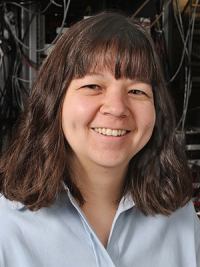 |
Fellowship of the American Association for the Advancement of ScienceDeborah Jin, Quantum Physics Division, was elected a 2006 AAAS Fellow for advances in the study of quantum gases and the properties of a Fermi degenerate gas. |
American Academy of Arts and SciencesEric Cornell, Quantum Physics Division, was elected a 2005 Fellow of the American Academy of Arts and Sciences for preeminent contributions to the science of Bose Einstein condensation and to society at large. |
 |
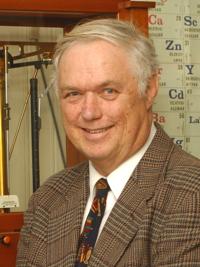 |
Washington Academy of Sciences Physical Science AwardAlbert Parr, Optical Technology Division, received the 2006 Physical Sciences Award from the Washington Academy of Sciences for leadership in developing state-of-the-art optical measurement facilities in support of national programs crucial to the U.S. economy and defense preparedness and reliant on modern optical radiation technologies. |
Washington Academy of Sciences Physical Science AwardPaul Julienne, Optical Technology Division, received the 2005 Physical Science Award from the Washington Academy of Sciences for pioneering studies of the theory of ultracold atomic collisions and its numerous applications that continue to impact forefront research, from Bose-Einstein condensation to atomic clocks. |
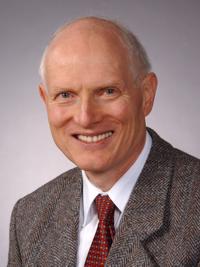 |
 |
Fellowship of the American Physical SocietyGarnett Bryant, Atomic Physics Division, was elected a 2006 Fellow for seminal contributions to nanooptics and to the theory of semiconductor quantum dots and other complex quantum nanostructures. |
Fellowship of the American Physical SocietyKristian Helmerson, Atomic Physics Division, was elected a 2006 Fellow for pioneering work in cooling, trapping, and coherent manipulation of cold atoms and for the development of seminal techniques for the manipulation and control of objects with optical tweezers.” |
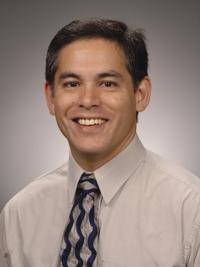 |
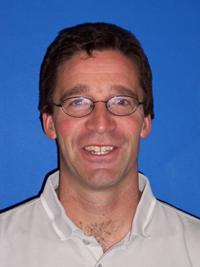 |
Fellowship of the American Physical SocietyDietrich Leibfried, Time and Frequency Division, was elected a 2006 Fellow for seminal contributions to the field of quantum information processing using trapped ions, including the demonstration of high fidelity logic gates and the implementation and application of entangled states. |
Fellowship of the American Physical SocietyWilliam R. Ott, Deputy Director, Physics Laboratory, was elected a 2006 Fellow for sustained leadership of the research and service programs of the Physics Laboratory of the National Institute of Standards and Technology. |
 |
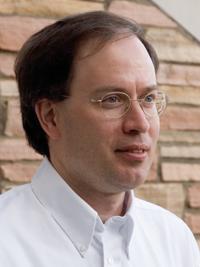 |
Fellowship of the American Physical SocietySteven Cundiff, Quantum Physics Division, was elected a 2005 Fellow for pioneering work in carrier-envelope phase stabilization of mode-locked lasers and its applications to optical frequency metrology and ultrafast technology. |
Fellowship of the American Physical SocietyEric Shirley, Optical Technology Division, was elected a 2005 Fellow for important contributions to the computation of the optical properties of solids from the infrared to the x-ray spectral regions. |
 |
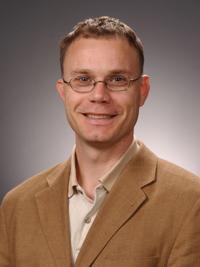 |
Fellowship of the American Physical SocietyEite Tiesinga,” Atomic Physics Division, was elected a 2005 Fellow for pioneering work on the measurement and control of cold atomic collisions by scattering resonances. |
Fellowship of the Optical Society of AmericaSteven T. Cundiff, Chief, Quantum Physics Division, was elected a 2005 Fellow of the Optical Society of America "for contributions to ultrafast laser spectroscopy of semiconductors and to carrier-envelope phase stabilization of mode-locked lasers." |
 |
 |
Fellowship of the Optical Society of AmericaJun Ye, Quantum Physics Division, was elected a 2006 Fellow of the Optical Society of America "for the application of frequency combs and ultrafast and ultrastable lasers to precision measurements and fundamental science." |
IEEE Senior MemberJohn Curry, Atomic Physics Division, was elevated to the grade of Senior IEEE Member in 2005. Only 7.3 percent of the IEEE members hold this grade, which requires experience reflecting professional maturity and significant professional achievements. |
 |
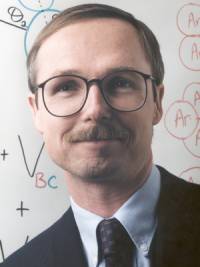 |
Royal Society of Chemists, UKDavid Nesbitt, Quantum Physics Division, was elected a 2005 Fellow in the Royal Society of Chemists for promoting the advancement of a wider application of chemical science. |
Doctor of Science (Honoris Causa), University of WaterlooMarilyn E. Jacox, Scientist Emeritus, Optical Technology Division, received the 2006 Doctor of Science (Honoris Causa) from the University of Waterloo "for her long and distinguished career in physical chemistry."The author of more than 175 scientific publications, Dr. Jacox has written a key book on spectroscopic data for transient molecules, such as free radicals, ions and other molecules having a transient existence. Her pioneering work helped to establish the field of matrix isolation spectroscopy for studying such molecules. |
 |
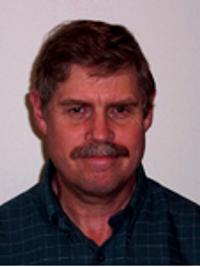 |
Health Physics SocietyChris Soares, Ionizing Radiation Division, was elected a Fellow of the Health Physics Society in 2006, "for substantial impact on the field of health physics, particularly in the areas of dosimetry, radiation source standardization, and standards development." |
Amazing Light: Vision for DiscoveryJun Ye, Quantum Physics Division, received the 2005 Technological Innovation Prize for Young Scholars for his paper "Optical Phase Control from 10-15 seconds to 1 second: Precision Measurement Meets Ultrafast Science." |
 |
 |
The Texas A & M Trotter Prize and Endowed Lecture SeriesWilliam D. Phillips, Atomic Physics Laboratory, received the 2006 Trotter Prize from Texas A&M University for pioneering contributions to the understanding of the connections between science and religion and their role in establishing a consistent worldview. |
IEEE International Solid-State Circuits Conference Jack Raper AwardJohn Kitching, Time and Frequency Division, with Clark T.C. Nguyen (DARPA, University of Michigan) received the 2005 Raper Award for Outstanding Technology Directions for the paper titled "Towards Chip-Scale Atomic Clocks." |
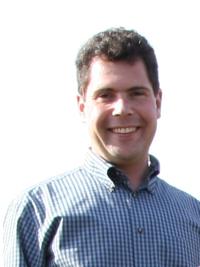 |
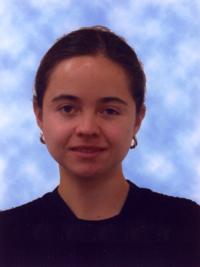 |
American Physical Society Outstanding Doctoral ThesisAna Maria Rey, a guest researcher in the Electron and Optical Physics Division, received the 2005 American Physical Society Outstanding Doctoral Thesis Award for her University of Maryland Ph.D. thesis research on "Ultracold Bosonic Atoms in Optical Lattices," conducted at NIST. |
American Physical Society Best Student-Paper Award in ExperimentChris Langer, a physics graduate student in the Time and Frequency Division, received the America Physical Society’s 2006 Best Student-Paper Award for his paper "Robust Quantum Memory Using Magnetic-Field-Independent Atomic Qubits." |
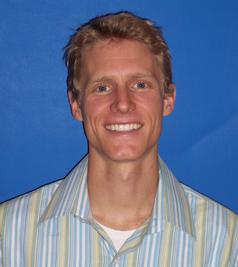 |
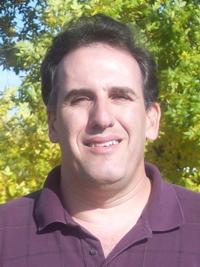 |
Best Paper Award International LORAN AssociationMichael A. Lombardi, Time and Frequency Division, received the 2006 Best Paper Award from the International Loran Association for his outstanding contribution to Loran and the Association in the preparation and presentation of the paper "The Potential Role of Enhanced Loran-C in the National Time and Frequency Infrastructure." |
National Conference of Standards Laboratories International Best Paper AwardJohn Kitching, Time and Frequency Division, received a 2005 NCSL Best Paper Award for "Chip-Scale Atomic Clocks at NIST.” |
 |
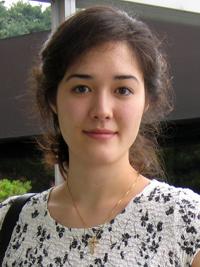 |
OSA New Focus/Bookham Student AwardVirginia O. Lorenz, received the 2006 OSA New Focus/Bookham Student Award for her presentation "Three-Pulse Photo Echo Peak Shift Measurements in Dense Potassium Vapor." |
Presidential Rank AwardThe Presidential Rank Award recpgmozes and celebrates career members of the Senior Executive Service (SES) and other senior career employees who are strong leaders and who consistenly demonstrate strength, integrity, industry, and a relentless commitment to public service. There are two categories, Distinguished and Meritorious. The President makes the selection following a rigorous review process coordinated by the U.S. Office of Personnel Management (OPM). |
| Katharine B. Gebbie received a 2006 Presidential Rank Award for
Distinguished Senior Executives and Professionals from the U.S. Office of
Personnel Management for sustained, extraordinary leadership and dedication
in creating and managing the NIST Physics Laboratory to an unprecedented
level of excellence. The NIST Physics Laboratory is the Nation’s foremost research laboratory in applying atomic, molecular, optical, and radiation physics to precision measurement science directed at national needs. It provides measurement services and reference data for U.S. industry and the technical community and develops new measurement methods aimed at driving innovation in emerging electronic, optical, and radiation technologies. Dr. Gebbie’s strategic leadership of the Physics Laboratory has resulted in three NIST scientists being awarded the Nobel Prize in Physics in the past 9 years and has vaulted the Physics Laboratory to being the foremost institute in the U.S. in quantum engineering, quantum computing, atomic timekeeping, and radiation metrology. |
 |
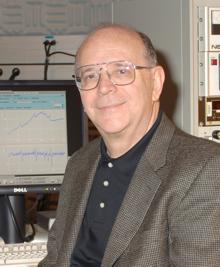 |
Robert J. Celotta, Electron and Optical Physics Division, received
a 2006 Presidential Rank Award for Distinguished Senior Executives and
Professionals from the U.S. Office of Personnel Management for scientific and
pioneering research in nanotechnology at the National Institute of Standards
and Technology. With more than 200 research publications in electron, atomic, and condensed matter physics, Dr. Celotta is an internationally recognized leader and pioneer in nanoscale science. His work in this area, begun 20 years ago, is directed at measuring the effect of atomic scale systems on the properties of electronic and magnetic devices. He and his group have developed several generations of pioneering scanning-probe and electron-spin polarization microscopes that have defined the state of the art of nanoscale measurement and led to new insights into the performance of magnetic recording devices, magnetic materials, and electronic systems. In 2006, Dr. Celotta was appointed Director of the NIST Center for Nanoscale Science and Technology. |
| William D. Phillips, Atomic Physics Division, received a 2005
Presidential Rank Award for Distinguished Senior Executives and Professionals
from the U.S. Office of Personnel Management for his leadership in the
development of laser cooling and trapping of atoms and its application to
atomic clocks and neutral atom quantum computing. For his pioneering work in the development of laser cooling of neutral atoms and its application to atomic clocks, and for his leadership in the U.S. effort in neutral atom quantum computing and the study and applications of ultracold degenerate quantum gases; for his contributions to NIST, from leading a dynamic and world-class research group, to working with the NIST Director as a NIST Fellow on issues of importance to the NIST community, and to promoting the relevance of atomic, molecular, and optical physics within the academic, government and industrial scientific communities; and for his commitment to sharing the joy and thrill of scientific discovery with people of all ages from all walks of life. |
 |
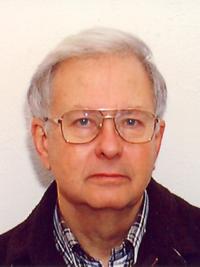 |
James E. Faller, Quantum Physics Division, received a 2006
Presidential Rank Award for Meritorious Senior Executives and Professionals
from the U.S. Office of Personnel Management for a career dedicated to
precision measurement science, with an emphasis on experimental gravitational
physics and tests of fundamental physical laws. For more than 40 years, Dr. James E. Faller has been a world leader in measuring and understanding gravity. His contributions include verifying Newton’s law of gravitation; devising laser-based methods to measure the Newtonian constant of gravitation; spearheading the use of laser interferometry to measure the acceleration of gravity; and conceiving the on-going lunar laser ranging experiment, which uses retro-reflector arrays placed on the moon by the Apollo astronauts. |
Samuel Wesley Stratton Award (NIST)The Samuel Wesley Stratton Award is granted for outstanding scientific or engineering achievements in support of NIST objectives. |
| Jun Ye, Quantum Physics Division, received the 2006 Stratton Award
“for femtosecond comb technology work which merges time- and frequency-domain
spectroscopic techniques and is enabling new developments in optical atomic
clocks." Jun Ye was recognized for his innovative and ground breaking work in atomic and molecular physics, precision measurement, and optical physics. Recently he has contributed a series of crucial advances: coherent synthesis of a single pulse from two independent lasers; an optical molecular clock; united time-frequency spectroscopy of cold atoms; “gainless” amplification by coherent addition of femtosecond pulses; and extension of the combs into the ultraviolet. These results form a technological base that NIST will utilize for years to come. |
 |
William P. Slichter Award (NIST)The William P. Slichter Award, first presented in 1992, is granted for outstanding achievements by NIST staff in building or strengthening ties between NIST and industry. |
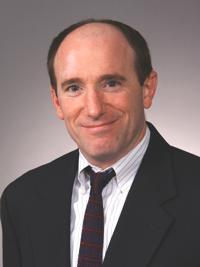 |
John Burnett, Atomic Physics Division, received the 2006
William P. Slichter Award, “for his pioneering contributions to the
development of immersion microlithography." By providing the microelectronics industry with highly accurate measurements of the index of refraction and associated optical properties of lens materials and fluids at deep ultraviolet wavelengths, Dr. Burnett helped this industry assess the practical feasibility of manufacturing future generations of microelectronics “under water” (and other fluids). Once thought to be an impractical idea, this “immersion lithography” technique is being seriously pursued by the industry because of the significant advantages it affords in reducing the effective wavelength and minimizing the circuit feature size. |
Allen V. Astin Measurement Science Award (NIST)The Allen V. Astin Measurement Science Award, first presented in 1984, is granted for outstanding achievement in the advancement of measurement science or in the delivery of measurement services. |
| Howard W. Yoon and Charles E. Gibson, Optical Technology Division,
received the 2005 Astin Award “for major advances in the realization and
dissemination of the NIST spectral irradiance scale widely used in
climate-change research." Dr. Yoon and Mr. Gibson were recognized for their development and dissemination of a NIST spectral irradiance scale, which has the lowest uncertainties of all the national metrology institutes. This effort required a new approach to realize the scale, using absolute detectors tied to the NIST cryogenic radiometer and a new facility to allow the scale to be disseminated using lamp standards. The climate-change research community will be one of the beneficiaries of this new scale since nearly all near-infrared to ultraviolet remote-sensing measurements worldwide are tied to NIST's spectral irradiance scale. |
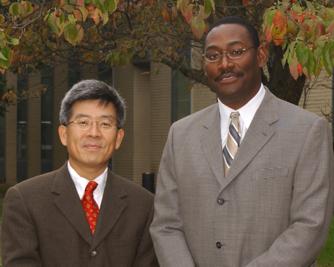 |
Edward Uhler Condon Award - 2005 (NIST)The Edward Uhler Condon Award, first presented in 1974, is granted for distinguished achievement in effective written exposition in science or technology. |
 |
Michael A. Lombardi, Time and Frequency Division, received the
2005 Condon Award "for publications aimed at informing not only technical
experts and manufacturers about NIST time and frequency services, but also
the general public." Mr. Lombardi was recognized for outstanding lead authorship of two publications describing NIST time and frequency measurement services: "NIST Time and Frequency Radio Stations: WWV, WWVH, and WWVB," G.K. Nelson, M.A. Lombardi, and D.T. Okayama, NIST Special Publication 250-67, and "WWVB Radio Controlled Clocks: Recommended Practices for Manufacturers and Consumers," M.A. Lombardi, A.N. Novick, J.P. Lowe, M. Deutch, G.K. Nelson, D. Sutton, W. Yates, and D.W. Hanson, NIST Special Publication 960-14. These publications describe some of NIST's most widely used services, including both technical details for the experts and clear and compelling explanations for the general public comprising most of the service users. |
Colleagues’ Choice Award (NIST)The NIST Colleagues' Choice Award recognizes non-supervisory employees at NIST who, in the eyes of their colleagues, have made significant contributions that broadly advance the NIST mission and strategic goals or contribute to the overall health and effectiveness of NIST. |
| Anita K. Sweigert, Physics Laboratory, received the Colleagues’
Choice Award “for extraordinary dedication to, and administrative support
for, the NIST Summer Undergraduate Research Fellowship (SURF) program." SURF was established in the Physics Laboratory 13 years ago to provide summer research internships to under-represented minorities. Now five times larger, it has broadened to include all of NIST. It is committed to providing research experiences to highly qualified young people likely to be society's future leaders, scientists, and engineers. Ms. Sweigert, the secretary to the director of the Physics Laboratory, developed the logistical system for planning and implementing the program. Her attention to detail, knowledge of the program, and ability to communicate effectively with officials and students from hundreds of universities every year, on behalf of all the NIST Laboratories, have provided enormous benefit to the NIST staff. |
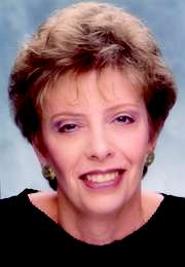 |
Gold Medal (DoC)The Gold Medal is the highest honor award conferred upon an employee by the Department of Commerce, for "distinguished performance characterized by extraordinary, notable, or prestigious contributions that impact the mission of the Department of Commerce and/or operating unit and which reflect favorably on the Department." |
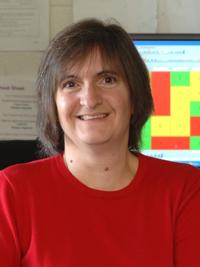 |
Lisa R. Karam, Ionizing Radiation Division, received a 2006 Gold
Medal, “for her leadership in developing radiation standards and measurement
methods needed in the national effort to ensure protection from terrorist
attack." An international expert in radiation measurements, Dr. Karam led the development of a national infrastructure for standards and measurements for radioactivity and ionizing radiation as it relates to countermeasures to potential terrorist attacks using radiological or nuclear material. Dr. Karam’s team developed standards for prevention, detection, response and recovery from radiation attacks as well as standards for x-ray inspection systems for explosives and radiological material. The equipment ranges from hand-held detectors for responders to large portal monitors for cargo containers. |
| Jabez J. McClelland, Electron and Optical Physics Division,
received a 2006 Gold Medal “for pioneering experiments on the fabrication and
replication of permanent nanostructures based on an atom optical control of
molecular beam epitaxy." Dr. McClelland led the development of a novel technique of nanostructure fabrication, which integrates laser cooling of atoms with molecular beam epitaxy. This resulted in a new length standard for scanning-probe microscopy, and points the way towards massively parallel fabrication of designer nanostructures. |
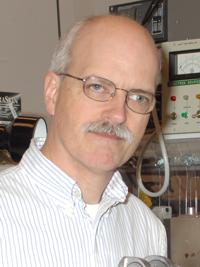 |
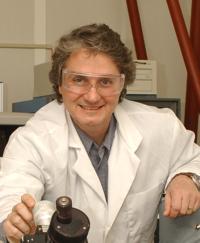 |
Joseph Stroscio, Electron and Optical Physics Division, received a
2005 Gold Medal “for the development of new instruments and methods to measure
nanostructure properties and for seminal research in nanoscale science and
technology." The innovations in STM instrument design Dr. Stroscio pioneered have found their way into a variety of research and commercial instruments and the methods he developed, e.g., normalized tunneling conductance, are practiced everywhere. His science has had a major influence on STM and STS metrology, the theory and practice of thin film growth, our understanding of magnetic multilayers, and the future of nanofabrication via atom manipulation. This is partially substantiated by the over 4000 citations his STM work has received to date in the scientific literature. No less impressive is the interest of the popular media, which have interviewed him many times on radio and television programs and made use of his impressive and informative images of nanostructures in magazines, websites, and textbooks. |
Silver Medal (DoC)The Silver Medal is the second highest honor awarded by the Department of Commerce, for "exceptional performance characterized by noteworthy or superlative contributions that have a direct and lasting impact." |
| Mitchell L. Furst, Electron and Optical Physics Division, received
a 2006 Silver Medal “for outstanding improvements in performance of the NIST
SURF III Synchrotron Ultraviolet Radiation Facility." Dr. Furst is cited for leading a transformation of the capabilities of the Synchrotron Ultraviolet Radiation Facility (SURF) III. Under his leadership since 2001, SURF III has delivered a 20-fold increase in optical output power. Its operational cycle has increased from 4 hours to 30 hours, allowing round-the-clock reliable and unattended operation, and its calibration services have entered new regions. This greater functionality has enabled NIST to effectively address growing customer demand from the semiconductor industry and NASA missions while decreasing staff workload. |
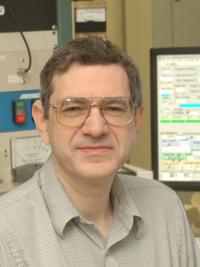 |
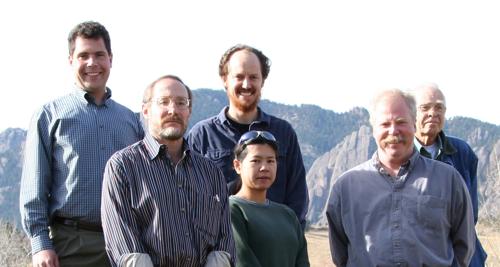
John Kitching, Leo Hollberg, Hugh Robinson, and Peter Schwindt, Time and Frequency Division, and John Moreland and Li-Anne Liew of the NIST Electromagnetics Division, received a 2005 Silver Medal “for designing, constructing, and operating the world's first ultra-miniature atomic clocks and magnetometers." |
These revolutionary devices promise to dramatically improve a wide range of applications through the use of atomically-precise measurements of time, frequency, magnetic fields and other properties in portable, battery-powered electronic devices. In recognition of the scientific and expected economic impact of this development, the chip-scale atomic clock was recognized as one of the “top science stories of 2004” by media that target both the general public and the technical community, including Discover Magazine, Science News, American Institute of Physics, Popular Science, et al. |
| Mark Stiles, Electron and Optical Physics Division, received a 2005
Silver Medal, "for exceptional contributions to the theory of magnetic
phenomena in nanostructures and thereby furthering US competitiveness in the
development of a wide array of magnetic sensors and information storage
devices." Dr. Mark Stiles’ theoretical work provided a complete fundamental understanding of several key areas of nanomagnetics relevant to the information storage industry, including exchange coupling, magnetic multilayer devices, giant magneto-resistance (GMR), and exchange biasing. All of these were crucial to the development of new nanotechnology based devices that have revolutionized the magnetic sensing and information storage industries. As a direct result, the rate of growth in storage density now exceeds one hundred percent per year, which even eclipses the current rapid rate of improvement of computer processor chips. |
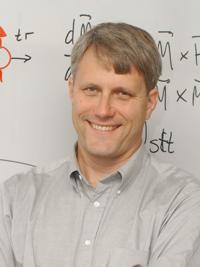 |
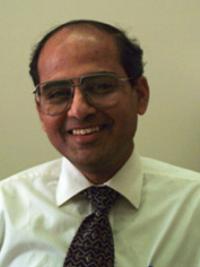 |
Raju Datla, Optical Technology Division, received a 2005 Silver
Medal “for directing the development of innovative infrared optical measurement
technology and standards to support critical national needs in missile defense
and climate-change research." Dr. Datla leads the development of innovative infrared optical measurement instruments, methods, and standards to support critical needs of the U.S. Missile Defense Agency (MDA), the Calibration Coordination Group (CCG), an organization that facilitates the development of standards for DoD, and the U.S. Climate Change Research Program and its lead member agencies, NASA, NOAA, and DoE. These measurements and standards have helped ensure the greatest return on our Nation’s investments in these multibillion dollar programs by establishing and maintaining the quality of infrared optical measurements which determine, for example, the reliability of target identification sensors in missile defense and the accuracy of satellite-measured sea-surface temperatures in climate-change research. Sea surface temperatures are an important measure of the ability of the large thermal capacity of the oceans to mitigate the expected rise in surface temperatures from climate change. |
Bronze Medal (NIST)The Bronze Medal is the highest honorary recognition available for Institute presentation. The award recognizes work that has resulted in more effective and efficient management systems, as well as the demonstration of unusual initiative or creative ability in the development and improvement of methods and procedures. It is also given for significant contributions affecting major programs, scientific accomplishment within the Institute, and superior performance of assigned tasks for at least five consecutive years.” |
| J. Trey Porto, Atomic Physics Division, received a 2006 Bronze Medal
“for the creation and leadership of a program in quantum information using
neutral atoms as qubits." Dr. Porto created a world-class experimental research team and apparatus to attack the problem of quantum processing with neutral atoms; conceived an approach that is robust and scalable; and developed the toolbox needed for making a simple quantum processor. He has made neutral atom quantum processing a key component of the NIST program in quantum information science and established that program as a world leading effort in neutral atom quantum computing. |
 |
 |
Julia J. Bachinski, Quantum Physics Division, received a 2006
Bronze Medal “for excellence in administrative support of science at JILA.” Ms. Bachinski provides grant administration for 27 JILA Fellows, supervises the JILA staff, and manages a $20 M+ annual budget. She shepherded the extremely complex NIST-CU cooperative agreement through renewal while performing her regular duties without interruption. Ms. Bachinski displays initiative and a can-do attitude. She implemented an improved expenditure tracking system which has greatly facilitated decision making by JILA scientists by providing a “real-time” balance for their funds. When approached for help on complex financial arrangements, she always looks for a way to achieve the scientists’ goals, rather than seeking to minimize her own effort. |
| David L. Jacobson, Ionizing Radiation Division, received a 2006
Bronze Medal “for his contribution in developing an advanced neutron imaging
facility for fuel cell research.” Dr. Jacobson's research has led to the development and application of cutting-edge neutron measurement techniques to address key technical barriers adversely affecting the development of robust and efficient hydrogen fuel cells, and has taken a lead role in the development of the world’s most advanced neutron imaging station to study water transport in fuel cells. This facility is now used by most major fuel cell manufacturers and automotive companies, and many universities and national laboratories. Through the research done at this facility, NIST is playing a crucial role in developing alternative power sources for the future, an area of extremely high national priority. |
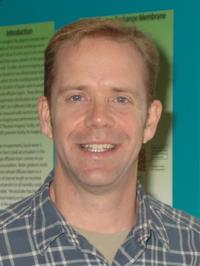 |
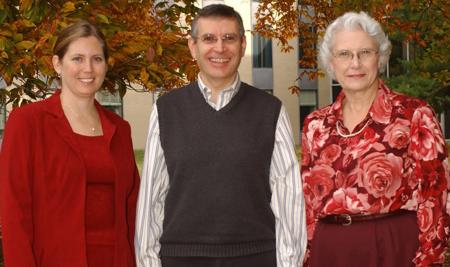 Robert Dragoset, Karen Olsen, and Gloria Wiersma, Office of Electronic Commerce in Scientific and Engineering Data (ECSED), Physics Laboratory, received a 2005 Bronze Medal “for pioneering the dissemination of physical reference data on the WWW and for providing outstanding customer service for more than 10 years." |
The ECSED office provided the first web accessible reference data at NIST in June 1994. Today there are 30 databases on www.physics.nist.gov/PhysRefData including seminal legacy publications that were converted into electronic form. The online databases receive more than 800,000 web page requests/month. One of the most popular is The NIST Reference on Constants, Units, and Uncertainty, with over 400,000 page requests/month. With input from data providers and customers, a unique graphical user interface is designed for each database to meet the needs of the user community, e.g., the ability to select among multiple data formats or to dynamically generate PDF files, graphs, and data values based upon user-supplied input parameters. |
| Alex Farrell, Electron and Optical Physics Division, received a
2005 Bronze Medal “for outstanding service to customers of the NIST
SURF III Synchrotron Ultraviolet Radiation Facility." Mr. Farrell is recognized for his outstanding contributions to the SURF III Synchrotron Ultraviolet Radiation Facility. He has consistently mastered many complex details in electronic and vacuum design and construction. His optimism, attentiveness to duty, and can-do attitude have won him the universal admiration of SURF users. He has become an essential member of the operations team, always performing beyond the normal expectations of his position. Mr. Farrell exhibits a work ethic and loyalty to his duties that follows the highest standards of NIST traditions. |
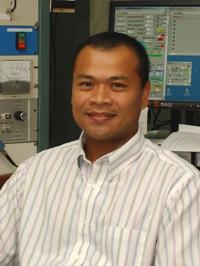 |
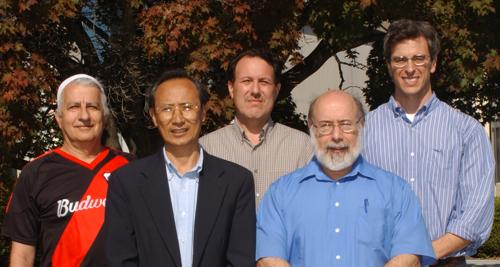
Joshua C. Bienfang, Electron and Optical Physics Divison, and Barry J. Hershman, Alan Mink, Anastase Nakassis, and Xiao Tang, Advanced Network Technologies Division, Information Technology Laboratory, received a 2005 Bronze Medal “for outstanding performance in advancing quantum cryptography towards commercial application." |
The team is cited for their outstanding engineering achievement in bringing quantum communications from the status of a laboratory demonstration to a technology addressing the needs of modern secure data communications. The team has demonstrated secure cryptographic key distribution over a 700 meter free-space link, and over 1 km of optical fiber, at rates exceeding 1 MHz, about 100 times faster than any previous demonstration. This accomplishment was recognized by the Optical Society of America as being among the most significant achievements in optics in 2004. |
| Eric L. Shirley and Adriaan C. Carter, Optical Technology Division,
received a 2005 Bronze Medal “for developing innovative computational and
experimental methods to accurately calibrate infrared sensors used in missile
defense." Drs. Eric Shirley and Adriaan Carter were recognized for their critical contributions for ensuring the accuracy of infrared sensors used to detect and track incoming ballistic missiles in support of the National Missile Defense System. Dr. Carter led a team of scientists in the development of new technology to calibrate the test chambers used in the calibration of infrared sensors for the Missile Defense Agency. Dr. Shirley applied sophisticated electromagnetic models of the test chambers to correct for optical diffraction effects limiting the accuracy of the sensor calibrations. |
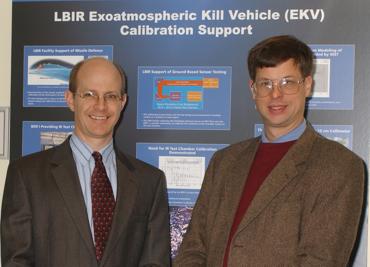 |
![]()